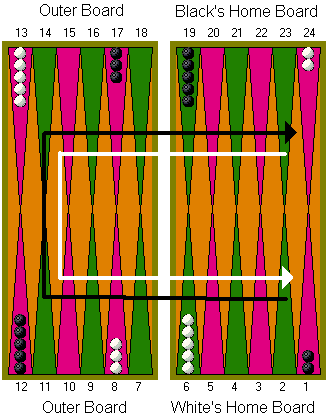 |
Backgammon |
|
Backgammon is a game for two players, played on a board consisting of 24 triangles (points). The triangles alternate in color and are grouped into four quadrants of six triangles each. The quadrants are referred to as a player's home board and outer board, and the opponent's home board and outer board.
The initial arrangement of stones is:
- 2 on each player's twenty-four point
- five on each player's thirteen point
- three on each player's eight point
- five on each player's six point.

Object
The object of the backgammon is move all your stones into your own home board and then bear them off. The first player to bear off all of their checkers wins the game.
Begin
To start the game, each player throws a single die. This determines both the player to go first and the numbers to be played. If equal numbers come up, then both players roll again until they roll different numbers. The player throwing the higher number now moves his checkers according to the numbers showing on both dice. After the first roll, the players throw two dice and alternate turns.
Move
- The roll of the dice indicates how many points the player is to move his stones. The stone is always moved forward, to a lower-numbered point.
- The numbers on the two dice constitute separate moves
- A player who rolls doubles plays the numbers shown on the dice twice.
- A player must use both numbers of a roll if this is legally possible (or all four numbers of a double).
- A stone cannot be moved to point that is not occupied by 2 or more opposing checkers.
- A point occupied by a single stone is called a blot. If an opposing checker lands on a blot, the blot is removed from the board and placed on the bar
- Any time a player has one or more checkers on the bar, his must enter those checker(s) into the opposing home board. A checker is entered by moving it to an open point corresponding to one of the numbers on the rolled dice.
Bearing off
- Once a player has moved all his checkers into his home board, he or she may start bearing off .
- A player bears off a stone by rolling a number that corresponds to the point on which the checker resides, and then removing that checker from the board. If there are no checkers on higher-numbered points, is permitted to remove a checker from the highest point on which one of his checkers resides.
- A player is under no obligation to bear off if he can make an otherwise legal move.
Doubling
Each game starts at one point. During the game, a player may feel that he or she has a sufficient advantage. In this case he or she can propose doubling the stakes.
This can be done this only at the start of his own turn and before rolling the dice.
A player who is offered a double may refuse, in which case he concedes the game with one point. play A player who accepts a double becomes the owner of te cube.
Redoubles are possible. If a player refuses a redouble, he must pay the number of points that were at stake prior to the redouble.
Automatic doubles
This is a optional rule.
If identical numbers are thrown on the first roll, the stakes are doubled.
The doubling cube is turned to 2 and remains in the middle.
End of the game
At the end of the game, if the losing player has borne off at least one checker,
he loses only the value showing on the doubling cube (one point, if there have been no doubles).
However, if the loser has not borne off any of his checkers,
he is gammoned and loses twice the value of the doubling cube.
If the loser has not borne off any of his checkers and still
has a checker on the bar or in the winner's home board,
he is backgammoned and loses three times the value of the doubling cube.





